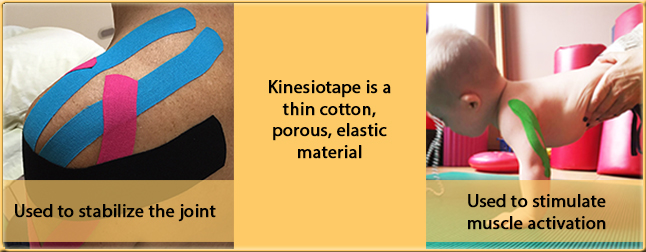Kinesiotaping
Was discovered by Dr. Kenzo Kase in Japan and started to become a popular treatment after the Olympic games in Beijing in 2008 when some athletes were seen using the tape.

Kinesiotape is a thin cotton, porous, elastic material used to support and stabilize muscles and articulations allowing the patient the freedom to move without restrictions. When applied, Kinesiotape has a lifting effect at the skin and on the deeper muscular structures and stimulates the receptors around the joints and muscles creating more interstitial space. This effect improves neurological, circulatory and muscular function. The results are activation of weak muscles, support to weak, unstable joints, liberation of intercellular pressure thereby improving circulation, reducing inflammation and pain. The tape can stay in place on the body for 3-5 days. It should be removed slowly after first applying baby oil on top to help unglue the tape.

- Physical Therapy
- Occupational Therapy
- Speech Therapy
- Early intervention through neurodevelopmental play
- Neuro-developmental Technique
- Importance of Therapeutic Play
- Myofascial Release (MFR)
- Craniosacral Therapy (CST)
- Kinesiotaping
- Treatment for Scoliosis
- Visual Stimulation
- Yoga for the Special Child ®
- Handwriting Without Tears
- Sensory Integration
- Compression Vest Therapy (Therasuit)
- Myofunctional Therapy
- Chronic Pain
- Modalities
- Soft Tissue Mobilization
- Pelvic Physical Therapy
- Treadmill Training
- Food School
- (CME) Cuevas Medek Exercises
